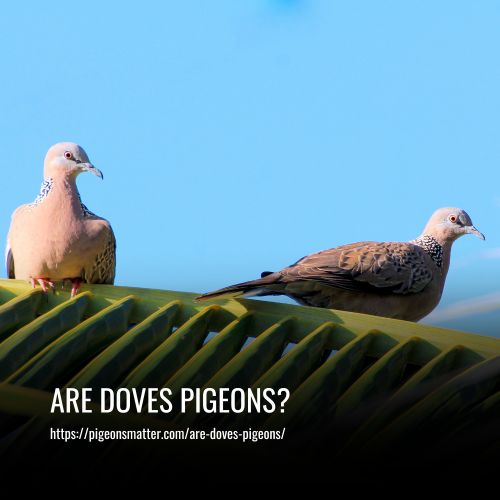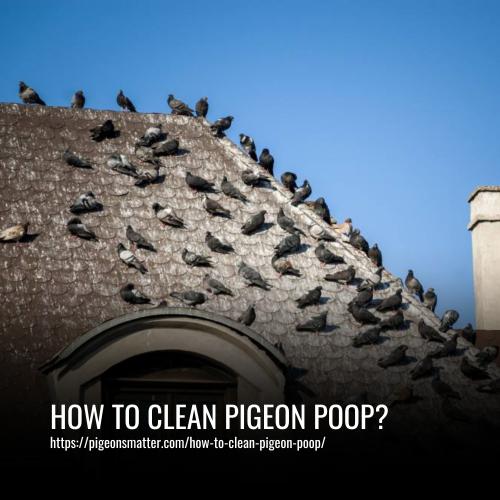Yes, doves and pigeons belong to the same family of birds, Columbidae. Doves are generally smaller and more elegant, while pigeons are larger and often have a stockier build. However, the terms “dove” and “pigeon” are often used interchangeably.

Dove vs Pigeon: What’s the Difference?
Many people have a misconception about the difference between doves and pigeons. They belong to the same family of birds, Columbidae, which consists of over 300 species.
Doves and pigeons possess comparable characteristics such as round bodies, short necks, and thin beaks, however, doves tend to be smaller while pigeons are larger and sturdier.
However, the terms “dove” and “pigeon” are interchangeable and can be applied to pigeon species and Dove species within the Columbidae family. There is no official scientific separation between the two. The terms came into existence due to different parts of the world having their names for these white birds.
While some people have their false distinctions between the two, none of these are scientifically recognized.
Two birds of the same feather
Did you know that pigeons and doves are actually the same species? They are both domestic pigeons or Columba livia domestica, which is a subspecies of the rock dove or rock pigeon, Columba livia. The North American Ornithologists Union committee on nomenclature has gone back and forth in terms of calling feral pigeons in cities “rock dove” or “rock pigeon”.
The bird family known as Columbidae includes over 300 species of pigeons and doves with evocative names like a mourning dove, white-crowned pigeon, and red-billed pigeon. The birds released during a wedding ceremony and those that leave droppings on cars are only differentiated by their breeding.
While not every pigeon is a homing pigeon, some can be trained to find their way home. This process involves gradually increasing the distance from the bird’s loft and waiting for the bird to get hungry before flying. This gives them a strong incentive to find their way back to their reliable food items. So, even though pigeons and white doves may look different, they are truly two birds of the same feather.
Variations of Columbidae
Columbidae, which includes both doves and pigeons, has a wide range of variations amongst its 310 species. These variations include size, with the largest species, the crown pigeon, being nearly the size of a turkey. The smaller species have a higher level of familiarity with humans and are more popularly recognized.
Columbidae tend to have short beaks and legs, and their small bodies make them well-suited for living among humans and nesting inside human structures. Additionally, they come in a variety of colors, or “plumage,” which has contributed to the perceived differences between doves and pigeons. There are distinct physical differences between doves and pigeons, with doves commonly having solid white feathers and pigeons often displaying varying colors on their rounded heads and necks.
While some Columbidae have dull shades of gray, white, and brown, there are also many species with much brighter colors. Ultimately, the terms “dove” and “pigeon” are simply personal preferences, as there is no real distinction between the two beyond generalizations.
1. Nesting Habits:
Columbidae, also known as pigeons, have adapted to living amongst humans and often construct their nests in human structures such as signs, gutters, and rooftops. This has led to an abundance of pigeons in large cities, where they have access to discarded food and fewer natural predators.
Whether living in the wild or a city, pigeons tend to build basic nests using materials such as sticks, grass, hay, and garbage. They typically lay one or two eggs and both the male and female help to raise their offspring, known as squabs. The time it takes for the squabs to reach maturity varies depending on the species.
It is common to see multiple pigeon families nesting nearby and flying together in large groups, known as a kit. Despite being viewed as pests in some parts of the world, pigeons have adapted well to living among humans and have unique nesting habits.
2. Diet:
The diet of Columbidae, which includes species of doves and white pigeons, mainly consists of seeds, fruit, and insects, much like many other birds. Depending on the species, they may either feed on the ground primarily on seeds and grains or in trees on fruits and insects. Although some species do feed on bugs and small reptiles, most Columbidae act as scavengers rather than hunters.
In urban areas, doves and pigeons are often fed scraps of food such as bread, fries, and chips, either given freely or scavenged from the garbage. However, this type of food is not necessarily healthy for them. Columbidae found in urban areas may display a range of health issues, varying from obesity to malnutrition.
3. Interaction with Humans:
The relationship between Columbidae and humans is complex and can have both positive and negative effects. Some species have thrived by living near human settlements and taking advantage of the resources available, while others have suffered and even gone extinct due to human activity.
One such example is the dodo, a species of Columbidae that was hunted to extinction. Despite being one of the most well-known extinct species, the dodo is not the only Columbidae species to have suffered at the hands of humans.
Certain species are considered pests due to their abundance, while others are in danger of extinction and require immediate action to prevent it. Approximately 60 species of Columbidae out of 310 are currently at risk. Humans need to consider the impact of their actions on these species and take steps to protect them.
4. Size:
The Columbidae family has a wide range of sizes, making it difficult to categorize doves and pigeons solely based on their size. The New World ground dove has a weight of 0.06 pounds and a length of 5 inches, making it the smallest member of its family.
On the other hand, the crowned pigeon is often compared to the size of a turkey, measuring around 30 inches long and weighing up to 9 pounds.
Generally, doves are considered to be the smaller members of the family, with weights up to 0.5 pounds, while pigeons are considered the larger species, with weights ranging from 0.5 to 9 pounds.
However, this is not a hard and fast rule and there are some birds, such as the common pigeon or rock dove, that fall in between both categories. These birds typically weigh between 0.5 and 0.8 pounds.
5. Tail:
When it comes to differentiating between pigeons and doves, one factor to consider is their tails. While there are exceptions, doves are typically known for having larger and more expressive tails compared to pigeons.
Their tails are often described as longer and more fanned out, especially during flight. On the other hand, pigeon tails are usually not as long or as fanned out as those of doves. Keep in mind that this is just a general guide, and there may be variations within each species.
FAQs
Doves do not always have a white appearance, despite common perceptions. This type of bird exhibits a range of colors, which may include grey, brown, white, or mixed patterns, resembling those found in pigeons.
Pigeons, like doves, have a label attached to them. However, the label for pigeons is not as favorable. They are often described as pests because they nest and flourish in urban areas. Many people have been accosted by pigeons desperate for scraps of food.
Pigeons are often considered pests due to their tendency to gather in large groups and scavenge for food in urban areas.
Pigeons and doves mostly eat seeds and fruit. Birds that mainly feed on seeds are called granivores, while those that eat fruit and insects are called frugivores.
The Columbidae family can be classified by distinguishing granivores in the Columbinae subfamily and frugivores in the other four sub-families. Both doves and pigeons can be found in both groups.
Homing pigeons are domesticated pigeons. They can find their nests from thousands of miles away. Rock Pigeons racing is a common use for them now. Carrier pigeons were utilized for message delivery during World War I and II. This was called “pigeon post” or “war post” because it was less likely to be intercepted than radios.
Conclusion:
While doves and pigeons may share many physical and behavioral characteristics, they are indeed two separate species. Though often used interchangeably, it is important to recognize the distinctions between doves and pigeons, as they each have their own unique qualities and characteristics.
Whether you are a bird enthusiast or simply curious about the natural world around you, understanding the differences between these two species can enhance your appreciation and knowledge of these fascinating creatures.


